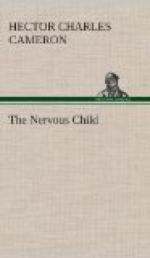his teeth are worrying him, or because he is hungry,
as we hear sometimes alleged, but because his mouth,
lips, and tongue are more sensitive, because more
plentifully furnished with the nerves of tactile sensation.
By constant practice the sense of touch and the precision
of the movement of his hands are slowly developed,
and not these alone, for the child in acquiring these
powers has developed also the centres in the brain
which control the voluntary movements. When the
child can walk he continues these grasping and touching
exercises in a wider sphere. As the child of
fifteen or eighteen months moves about the room, no
object within his reach is passed by. He stretches
out his hand to touch and seize upon everything, and
to experience the joy of imparting motion to it.
The impulse to develop tactile sensation and precision
in the movements of his hands compels him with irresistible
force. It is foolish to attempt to repress it.
It is foolish, because it is a necessary phase in
his development, and moreover a passing phase.
No doubt it is annoying to his elders while it lasts,
but the only wise course is to try to thwart as little
as we can his legitimate desire to hold and grasp
the objects, and even to assist him in every way possible.
But the mother must assist him only by allowing free
play to his attempts. To hand him the object is
to deprive the exercise of most of its value.
Incidentally she may teach him the virtue of putting
things back in their proper places, an accomplishment
in which he will soon grow to take a proper pride.
If she attempts continually to turn him from his purpose,
reproving him and snatching things from him, she prolongs
the grasping phase beyond its usual limits. And
she does a worse thing at the same time. Lest
the quicker hands of his nurse should intervene to
snatch the prize away before he has grasped it, he
too learns to snatch, with a sudden clumsy movement
that overturns, or breaks, or spills. If left
to himself he will soon acquire the dexterity he desires.
He may overturn objects at first, or let them fall,
but this he regards as failure, which he soon overcomes.
A child of twenty months, whose development in this
particular way has not been impeded by unwise repression,
will pick out the object on which he has set his heart,
play with it, finger it, and replace it, and he will
do it deliberately and carefully, with a clear desire
to avoid mishap. Dr. Montessori, who has developed
into a system the art of teaching young children to
learn precision of movement and to develop the nerve
centres which control movement, tells in her book
a story which well illustrates this point.[1]
[Footnote 1: The Montessori Method, pp. 84, 85.]




